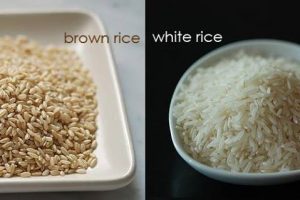Rice
This is one of a series of articles on food written by David Murray (see the full list on the right hand sidebar).
 So here’s yet another diet-based dispute. White or Brown rice? Which is the better choice?
So here’s yet another diet-based dispute. White or Brown rice? Which is the better choice?
Firstly, rice is rice is rice is rice. Before it is touched by human hands it is a grass seed. Like all plant-products there are different breeds and species, but white and brown rice are both still rice. The difference? Processing.
So brown rice has all the parts it grew with. The germ, endosperm, bran and awn. Only the hull is removed during milling, leaving this thing as close to natural as possible.
Starting to sound pretty good, right? (Wait for it)
The bran layers are what give the rice its brown colour, and also hold a host of micronutrients. Brown rice has more fibre and protein.
Yay! More good news. (Waaaaait for it!)
And brown rice is often praised for its lower glycaemic index (GI) than white rice. That means it is slower at increasing blood sugar and doesn’t push blood sugar as high (when eaten alone after a night of fasting. Which we all regularly do with rice, right?)
But wait for it.
Those nutritious bran layers that sound so good on paper have a critical flaw that throws a spanner in the works. They contain phytates and lectins.
(gasp!)
Wait, what are they again? They come up again and again in my articles. Definitely worth committing to memory.
They are known as ‘anti-nutrients’. They bond with nutrients in our food, lowering their bioavailability. So even though brown rice has (slightly) more NUTRIENT CONTENT than white rice, you’re not necessarily absorbing it into your system. They become shielded against our bodies, and pass right on through. A higher nutrient content doesn’t always equal a higher nutrient intake.
And even if it did, rice is not the place to go for nutrients. It’s that ‘micro’ on the front of micronutrient that should give it away. We’re talking tiny amounts. Throw some veggies and chicken into your rice and you’ve rendered the difference obsolete. Rice is rice. We’re back to that.
So white rice is just brown rice with some extra milling. Now we’ve removed the bran layers, awn and the germ as well, leaving just the white endosperm. And with the bran goes most of the micronutrients, and the phytates and lectins as well. But that’s not to say that white rice is less nutritious than brown. The actual nutrient content is only slightly lower, but the anti-nutrients are gone so you can easily absorb them into your body.
There is also a slight difference in how our digestive systems handle each different rice.
What with the micronutrients and anti-nutrients and all, your body is doing a little more to work through some brown rice. This can cause you some problems if you have existing digestion issues, like intolerances or leaky gut syndrome. If not, it shouldn’t be causing you any problems. White rice, on the other hand, is easy breezy. No matter your intolerances, white rice is almost always problem free in the digestion department.
So which is the healthier choice? This writer votes white! But what really makes a difference is what you pair it with. Choosing a balanced diet and avoiding sauces with additives by making your own is the only sure-fire way to get the most out of your rice.
